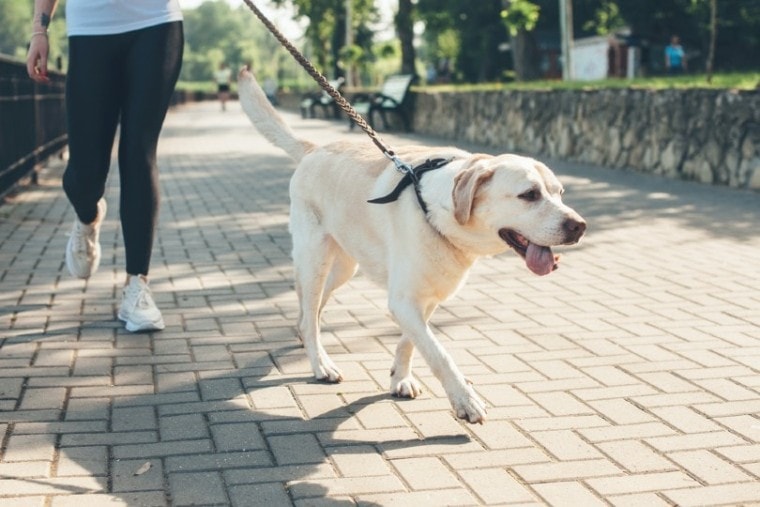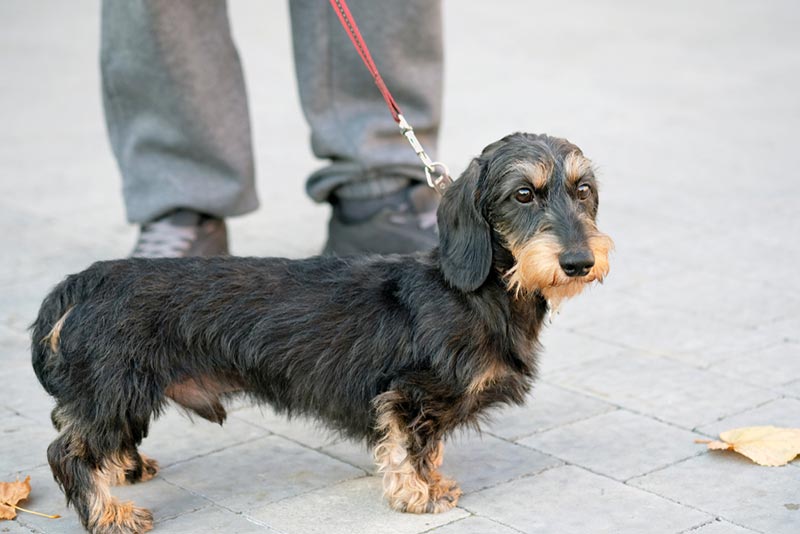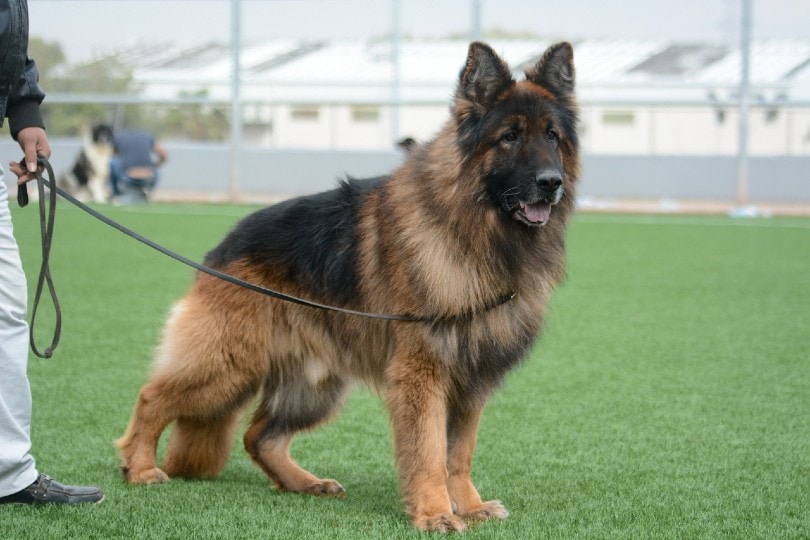
Are you trying to train your puppy how to walk on a leash but are unsure how to start? Do you have an adult dog that tends to pull every time you take them out on a walk? People sometimes assume that dogs will instinctively know how to properly walk on a leash, but that isn’t the case. As with other behaviors, walking on a leash must be learned. Fortunately, teaching your dog good leash skills isn’t as hard as you may think.
In this how-to guide, you will find everything that you need to know about teaching your dog to walk on a leash, from the basics to the best tips to try.
Top 5 Tips for Training Your Dog to Walk on a Leash
1. Introduce your dog to their collar and leash.
If you have a puppy, it may take a while for them to get used to wearing a collar. Before you ever take them outdoors, you should spend time in your home getting your dog accustomed to wearing a collar and leash. If you feed them treats whenever they wear the leash, they will positively associate leash time with fun time.

2. Practice walking your dog inside.
Once your dog is accustomed to their leash, practice taking them on short walks inside. If possible, find a quiet area of the house to practice walking in so there aren’t too many distractions.
3. Teach your dog to stay on one side.
Use your indoor practice time to teach your dog to stay on one side of you, to prevent them from tripping you up. If you intend to have your dog compete in sports and competitions, you should train them to walk on your left side, as this is the traditional side. If you don’t plan to compete, you can train them to walk on whichever side is most comfortable for you. If you’re right-handed, you may find that it’s most comfortable to keep your dog on your right.
The best way to keep your dog by your side is to keep their leash relatively short so they can’t circle or zigzag. You can also give them treats only when they stay on the appropriate side.

4. Once your dog has mastered indoor walks, take your walks outdoors.
Put your dog’s skills to the test by taking them outdoors for their first real walks. Understand that the outdoors will inevitably present many new distractions for your dog. You will need to be patient with your pet, and ideally, you should keep the first several walks short. Move away from objects that are distracting your dog during the walk. Once they move away from the distraction to follow you, give them a treat as a reward. Over time, you can reduce the number of treats that you give your dog while out on walks.
5. Finally, work through leash problems.
Even if your dog or puppy is a quick learner, you are likely to run into a few problems along the way.

Leash Pulling
One of the most common problems is leash pulling. If you find that your dog tends to pull on their leash, try staying still when it happens and remaining that way until your dog comes back to you again. Don’t yank on the leash, as you could harm your dog. Reward them with treats for coming back to stay with you. This way, they will learn that staying with you, not pulling ahead, is a good thing.
If you continue to have problems with pulling, you may need to get a head halter or a different collar so you can gain more control over the pulling. A head halter is a type of collar that wraps around your dog’s muzzle instead of their neck.
Lunging
Lunging is most common in dogs with high prey drives or herding breeds, but it can be a problem in any dog that has a tendency to get excited. If your dog tends to lunge at people or objects while you’re walking, pay attention so you can be proactive. If possible, get your dog’s attention with a treat when you see a possible target coming so they will be too distracted to try and lunge.
Barking
Excessive barking is usually the result of boredom. If you find that your dog barks frequently while you’re out for walks, try increasing the amount of mental stimulation and exercise that they are getting. If barking is still an issue, you can use the same method that you would use for a dog that tends to lunge: Redirect their attention with a treat before they have a chance to bark. If your dog tends to bark when they see other dogs, for example, they will hopefully start to get into the habit of turning to you instead of barking when other dogs walk by.

Leash Basics
Choosing a Collar
First, you need to ensure that your dog’s collar is the proper size. A collar that is too big could slide off, but a collar that is too tight could harm your dog. In general, you can loosely measure your dog’s collar by trying to slide your fingers between the collar and your dog’s neck. The collar should be snug enough so no more than two fingers will fit underneath. You can also use a measuring tape to find your dog’s neck size. Pet stores may recommend certain collars for certain breeds, but it is still important to measure to get the correct fit.
Second, your dog’s overall size and breed should be taken into consideration when choosing the width of your dog’s collar. A wide collar (1–2 inches) will provide more support, making it suitable for large and strong dogs. Conversely, a narrow collar (⅝–1 inch) is appropriate for small breeds.
Choosing a Leash
Leashes come in many different styles, materials, and lengths. A standard leash is typically 4–6 feet long and ⅜–1 inch wide. Nylon is the most common leash material because it is affordable and easy to clean. However, if your dog likes to chew on their leash, nylon may not be the best option because it can be easy to chew through. You can opt for a rope or leather leash for a sturdier material, but you should keep in mind that leather in particular can be difficult to clean. For a hypoallergenic option, choose a hemp leash. Hemp is unlikely to bother a dog with sensitive skin.
If you find that a standard leash doesn’t work for you and your needs, there are several other options to choose from, including retractable leashes, adjustable leashes, and umbilical leashes. Each of these options has benefits and drawbacks.

Retractable Leashes
If your dog likes to wander, a retractable leash may be a good option. However, you should know that they can cause injury to humans and dogs if your pet is not trained properly. In particular, if your dog has a high prey drive and has a tendency to bolt after objects and animals that have caught their interest, a retractable leash can cause neck injuries because it gives your dog leeway to run at full speed—until they reach the end of the leash, causing a sudden lurch.
Adjustable Leashes
Since adjustable leashes have clasps on both ends, they can be ideal if you need to tie your dog to a post or a tree or if you want to walk multiple dogs at a time. You can even loop an adjustable leash around your waist while walking your pup so you don’t have to hold onto the handle, though this type of leash isn’t recommended if you plan to take your dog for a run or hike.
Umbilical Cord Leashes
Umbilical cord leashes are great hands-free options for an active pup. You can buckle these leashes around your waist while on the go but maintain control over your dog due to two built-in handles. This type of leash also has a bungee cord that prevents injury as you start and stop while out for a run.
At What Age Should You Leash Train a Puppy?
You may be surprised to learn that you can start leash training your puppy as early as 7 or 8 weeks old. Dogs begin to solidify their adult behaviors from a very early age, so if you wait too long to start training your dog to walk on a leash, you may be missing an opportunity to set expectations for your dog’s behavior. Of course, if you start training a puppy that young, you will need to be patient. Make sure you are using plenty of repetition and positive reinforcement along the way.
Conclusion
With enough practice and patience, your dog will be ready to walk on a leash in no time. If you try all these tips and you still have issues with pulling, lunging, or barking, your best bet is to take your dog to obedience school so they can work with an experienced trainer. The sooner you correct bad habits, the easier it will be for your dog to learn new, better habits.
Featured Image Credit: dekazigzag, Shutterstock








